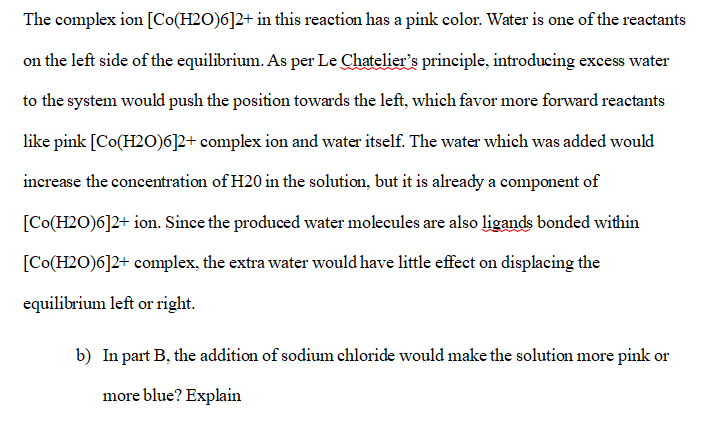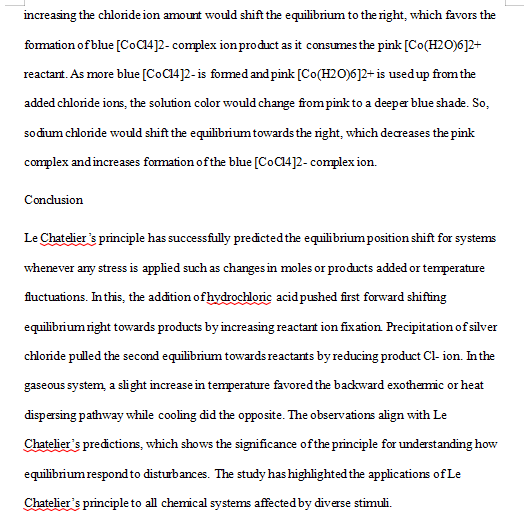The report examines Le Chatelier’s principle and its use in predicting the action of various stresses on chemical equilibrium. Le Chatelier’s principle says if a stress is place on the system at equilibrium, then the position on the balance will move in order to oppose change. The selected three chemical systems are analyzed upon dissociation by changes in reactant and concentration, product concentration and temperature. Observations are recorded both before and after applying stresses that may be analyzed on the basis of Le Chatelier’s principle.
Part A: Increasing the amount of reactant
| Observations BEFORE the addition of HCl | Predictions of what will happen | Observations AFTER the addition of HCl | Explanation of results using Le Chatelier’s principle |
| Regarding the product aspect, there will be a rise in the concentration of chloride ions. | There will be an increase in the concentration of chloride ions on the product side. As per Le Chatelier’s principles says, this change will prompt the equilibrium of the reaction to shift in favor of the reactant side. There will be a decrease in the concentration of [CO (H2O)6]2+ and a rise in the concentration of [COCl4], as more [CO(H2O)6]2+ and Cl- ions combine, resulting in the formation of additional [COCl4]2- ions and water molecules. | Upon the introduction of HCl, the solution changed its color to blue. | The addition of hydrochloric acid (HCL) to the solution containing saturated complex ion [Co(H2O)6]2+, caused the solution to turn blue which indicates that the equilibrium shifted to favor the formation of more of the [Co(H2O)6]2+ complex ions. According to Le Chatelier’s principle. New [CoCl4]2- ions formed by ligand exchange reactions where chloride ions from HCl replaced some of the water molecule ligands on [Co(H2O)6]2+ ions. The water ligands were released into solution as the [CoCl4]2- was developed. The color change and formation of [CoCl4]2- signify that adding the strong acid HCl caused the equilibrium to shift towards the reverse reaction, which favors the complex ions and chloride ions over the [CoCl4]2- complex and water. The observations align with expectations from Le Chatelier’s principle when excess chloride ions were introduced from the HCl. |
Part B: Decreasing the amount of a reactant
| Observations BEFORE the addition of AgNO3 | Predictions of what will happen | Observations AFTER the addition of AgNO3 | Explanation of results using Le Chatelier’s principle |
| As per Le Chatelier’s principles, the reaction will shift the equilibrium to favor reverse reaction on products side. | The addition of (AgNO3) to the solution [CO (H2O)6 ]2-+ 4 Cl-[COCl4 ]2-+ 6H2 O, a white precipitate of silver chloride (AgCl) is expected to form. The silver ions (Ag+) introduced by the AgNo3 would combine with chloride ions to form insoluble AgCl. | When silver nitrate (AgNO3) was introduced, a white precipitate formed. As the solution was mixed, the color shifted from initial blue to a pink | When silver nitrate (AgNO3) was added, the silver ions (Ag+) combined with chloride ions (Cl-) to form a white precipitate of silver chloride (AgCl). The solution color changed from the initial blue to pink. The blue color likely originated from the [Co(H2O)6]2+ complex ions. As the silver-chloride precipitate formed, these blue [Co (H2O)6]2+ complex ions may have been converted to pink [CoCl4]2- by ligand substitution. As per Le Chatelier’s principle, the precipitation of AgCl would shift the original equilibrium to favor products, [CoCl4]2- and water. The solid AgCl formation and color change from blue to pink are consistent with an equilibrium shift towards more [CoCl4]2- products, as predicted when silver ions were introduced. |
Part C: Changes in Temperature
| Observations BEFORE the change in heat | Predictions of what will happen | Observations AFTER the change in heat | Explanation of results using Le Chatelier’s principle | |
| Hot water tube | If heat is added to the system at equilibrium, as per Le Chatelier’s principle, the position will shift to help counteract the increased temperature. In this case, increasing temperature will push the equilibrium to the left, favoring the endothermic reverse reaction from N2O4 to NO2. So heating causes the gaseous equilibrium to shift left, to convert more colorless N2O4 to brownish NO2 gas. | As per Le Chatelier’s principle, if the temperature is increased in the reaction, the equilibrium will shift to counteract the temperature rise. Since the forward direction forming NO2 from NO is an endothermic reaction, it absorbs heat energy. When the temperature increases, the equilibrium will favor the endothermic forward reaction to form reddish-brown NO2 gas. | As per Le Chatelier’s principle, if a stress is applied to a system at equilibrium, the is going to shift to counteract the stress and establish a new equilibrium. In this case, when additional nitrogen dioxide (NO2) gas, a brownish color, is added to a hot bath, it causes two stresses; an increase in NO2 concentration, and a temperature. The equilibrium between NO2 and colorless dinitrogen tetroxide (N2O4) will shift left towards the reverse reaction to oppose these changes. The endothermic reverse reaction from N2O4 to NO2 absorbs heat, to counteract the hot bath temperature rise. As more N2O4 forms, the added NO2 is consumed, which lowers its concentration. | |
| Cold water tube | A cooling of the system will cause the equilibrium to move to the right, favoring exothermic reaction and releasing more energy | Reduced temperature would favor the exothermic direction of the reaction, which is the energy-releasing reverse reaction (formation of N2O4). Since N2O4 is a colorless gas, as the equilibrium shifted in favor of its formation, the gasses in the tube would turn colorless. | The tube’s color fades when cooled in a cold bath since the amount of brown nitrogen dioxide (NO2) decreases | As per Le Chatelier’s principle, adding stress to an equilibrium system will cause the system to counteract the stress by shifting the equilibrium position. In this case, when additional nitrogen dioxide (NO2) gas, a brownish color is added to a cold bath, it imposes two stresses; increase in NO2 concentration, lowered temperature.The equilibrium between NO2 and colorless dinitrogen tetroxide N2O4 will shift to the right towards the forward exothermic reaction to oppose these changes. The extra heat released from the forward reaction will counteract the cooling from the cold bath. As more brown NO2 forms from colorless N2O4, the added NO2 is used up, which lowers its concentration. As predicted by Le Chatelier’s, adding NO2 to cooling pushes the equilibrium right, which increases brown NO2 concentration by the exothermic forward pathway, and also liberates heat to offset the dop in temperature. |
Question 1



